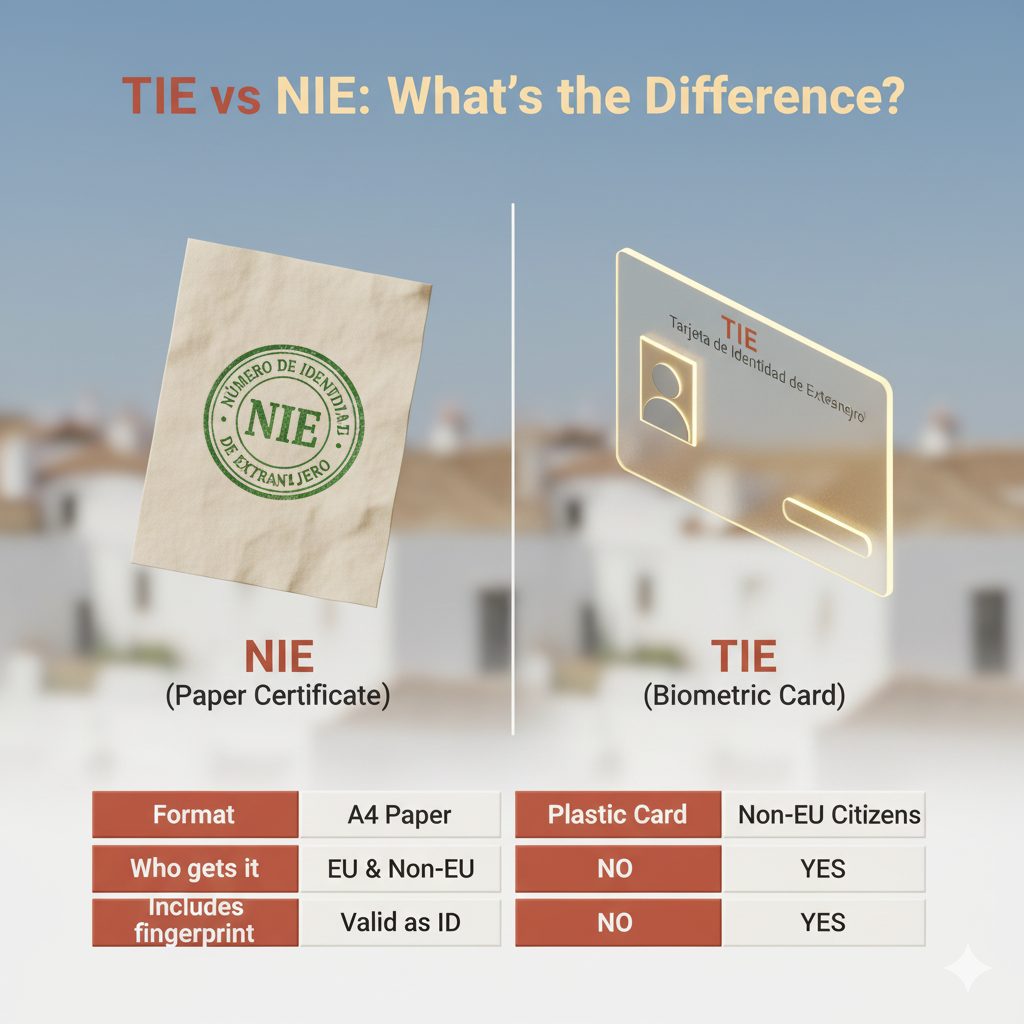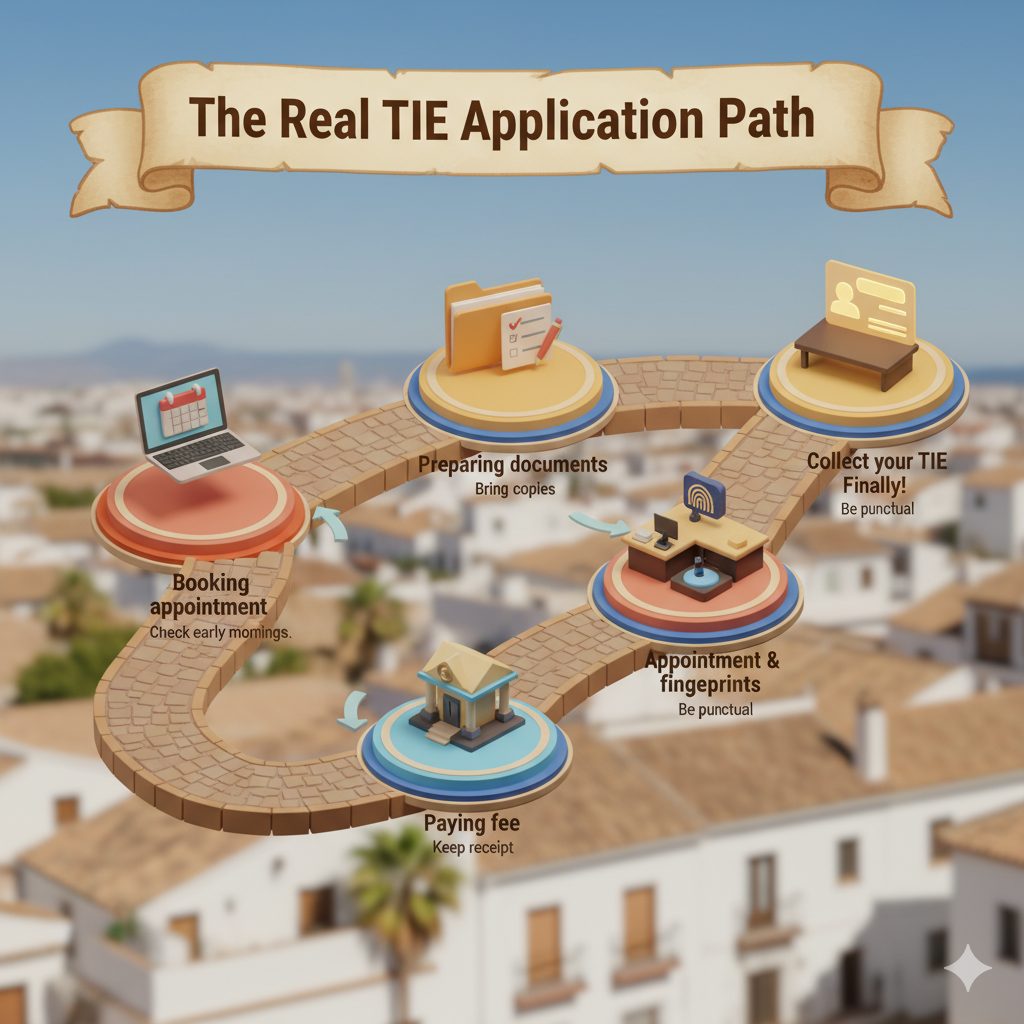Applying for your TIE card in Spain can feel like entering a labyrinth of forms, appointments, and waiting rooms. The process looks simple on paper — book a slot, bring documents, and collect your card — but in reality, it’s rarely that linear.
At e‑Residence, we’ve guided hundreds of foreigners through it. And while Spain’s system isn’t the fastest, there are clear ways to make it smoother. In this guide, we’ll skip the bureaucratic jargon and share what really matters when applying for your Tarjeta de Identidad de Extranjero — from timing tricks to insider advice on what to do when appointments disappear.
Understanding the TIE: Why It Matters
The TIE (Tarjeta de Identidad de Extranjero) is your official residence card — the plastic document that ties together your visa, NIE number, and legal status. It’s your proof of identity as a foreign resident in Spain.
You’ll need it for everything: opening a bank account, registering with social security, signing contracts, traveling, or even receiving parcels that require ID. Without it, you’ll quickly discover that Spain runs on paperwork — and the TIE is your ticket to participate.
TIE vs. NIE — What’s the Difference?

Many newcomers confuse the two, so let’s clear it up. The NIE (Número de Identidad de Extranjero) is simply a tax identification number. It can exist without a physical card. The TIE, on the other hand, is the actual card that proves your residence.
| Feature | NIE | TIE |
|---|---|---|
| What it is | Identification number | Residence identity card |
| Format | Paper document or digital number | Biometric plastic card |
| Used for | Taxes, forms, contracts | Legal proof of residence and ID |
| Who gets it | EU and non‑EU residents | Mostly non‑EU residents |
| Includes NIE number | Yes | Yes |
Spain used to issue paper versions — NIE Blanco and NIE Verde — but today, the TIE has replaced them with a secure, chip‑based card.
The TIE Process: What Actually Happens
Official guides make it sound easy, but most applicants discover that real life brings surprises. Here’s what actually works in 2025.
Step 1: Booking the Appointment
⚠️ Keep in mind the 30-day rule: you must apply for your TIE within 30 calendar days of entering Spain. Many newcomers miss this window and have to restart the visa process — especially non-EU citizens.
You’ll book online through the government’s portal under Policía – Expedición de Tarjeta de Identidad de Extranjero. But the hard part isn’t filling the form — it’s finding an available slot.
Pro tip from our team: check early mornings (between 7:30–9:00 AM) or mid‑week evenings. Refresh often — new slots open randomly. If you live in Madrid or Barcelona, consider smaller nearby towns. Sometimes a short train ride saves weeks of waiting.
Before you can even apply for your TIE, you must register your address — this is called Empadronamiento. It’s done at your local town hall (Ayuntamiento). The certificate must be issued within the last three months; older ones are automatically rejected during your TIE appointment.
Step 2: Preparing the Paperwork
This is where many people get delayed. Spain loves official documents — and copies. Lots of them. Make sure to have:
- A valid passport (original + photocopy)
- Completed EX‑17 form
- Proof of residence (empadronamiento, lease, or utility bill)
- Two photos (Spanish ID format, not US size)
- Payment receipt for fee form 790/012
- Health insurance proof (if required by your visa)
If you’re working or freelancing, you’ll also need your Spain Social Security Number.
📋 Checklist:
Bring two copies of everything. Label your documents. Spain’s immigration offices rarely explain what’s missing — they just hand back your folder.
Step 3: Paying the Fee
The form 790/012 must be paid at a bank before your appointment. Most banks prefer cash for this. Keep the receipt safe — without it, you won’t be seen. The fee ranges from €16 to €20 depending on your residence type.
Step 4: The Appointment Itself
Expect a quick but bureaucratic experience. You’ll hand in your documents, give fingerprints, and get a receipt (resguardo). Some offices take 10 minutes, others take 40 — it depends on the officer. Don’t argue; polite patience goes a long way.
If your paperwork is fine, you’ll be told when to return to collect your card — usually in about a month.
Note that the process involves two separate appointments — the first for submitting documents and fingerprints, and the second (a few weeks later) for collecting your physical card. Forgetting to book the second one can delay your card by months.
Step 5: Collecting Your TIE
When you return, bring your passport and the resguardo. Processing time varies by city, as shown below:
| City | Average Wait (2025) | Notes |
|---|---|---|
| Madrid | 90–120 days | High backlog; book as early as possible |
| Valencia | 45–60 days | Moderate waiting times |
| Malaga | 25–40 days | Faster processing, but fewer slots available |

Common Mistakes (and How to Avoid Them)
- Wrong form version: always download a fresh EX‑17 from the government website — older versions get rejected.
- Appointment not confirmed: after booking, make sure you receive the confirmation email; otherwise, the system deletes it.
- Outdated proof of address: your empadronamiento must be less than three months old.
- No photocopies: bring them even if not listed. Many officers refuse to make copies for you.
- Expired visa: applying late can void your status. Book your TIE appointment as soon as you enter Spain.
What No One Tells You About the TIE
- You can’t apply without your physical visa in the passport. Even if your visa approval email looks official, officers need to see the stamp.
- Each province has different tolerance levels. Madrid might ask for extra documents, while Malaga is far more relaxed.
- Don’t panic about language barriers. If you don’t speak Spanish, bring a friend or translator — most officers appreciate the effort.
- Timing is everything. Spain’s immigration system resets every few hours; try reloading the appointment page during lunchtime or late evening.
Renewing Your TIE (and Why You Shouldn’t Wait)
Your TIE must be renewed when your residence permit or visa changes. The renewal follows almost the same process — but don’t wait until the expiry date. Start 60 days before to keep your status active.
If you renew early, your current card remains valid until the new one is issued, so you can continue to work, travel, and live in Spain without interruption.
Obligations After Receiving Your TIE
Getting your card isn’t the end — it’s the beginning of your administrative life in Spain. Once you have it:
- Register with your local health centre.
- Update your address whenever you move.
- Keep digital copies of your TIE and visa.
- Always carry your card — it’s your official ID for everything from deliveries to driving licences.
Real‑World Advice from e‑Residence
After helping hundreds of clients through this process, here’s what we’ve learned:
- Arrive early, be polite, and bring your documents in order — it genuinely speeds things up.
- Don’t assume all advice on expat forums applies to your case. Spain’s bureaucracy is local — what works in Valencia might fail in Madrid.
- Make digital backups of every document you submit.
- Most delays happen because applicants overlook one small detail — signatures, copies, or expired proofs.
Final Thoughts
The TIE process isn’t impossible — it’s just Spanish. It rewards patience, preparation, and good timing. Once you have your card in hand, you can fully enjoy your new life: open accounts, register for healthcare, or even apply for your digital certificate.
At e‑Residence, we’re here to make that process easier — not just by explaining the rules, but by sharing what actually works. Because when it comes to Spanish bureaucracy, a little insider knowledge can save you weeks of waiting.
Last updated: 30.10.2025